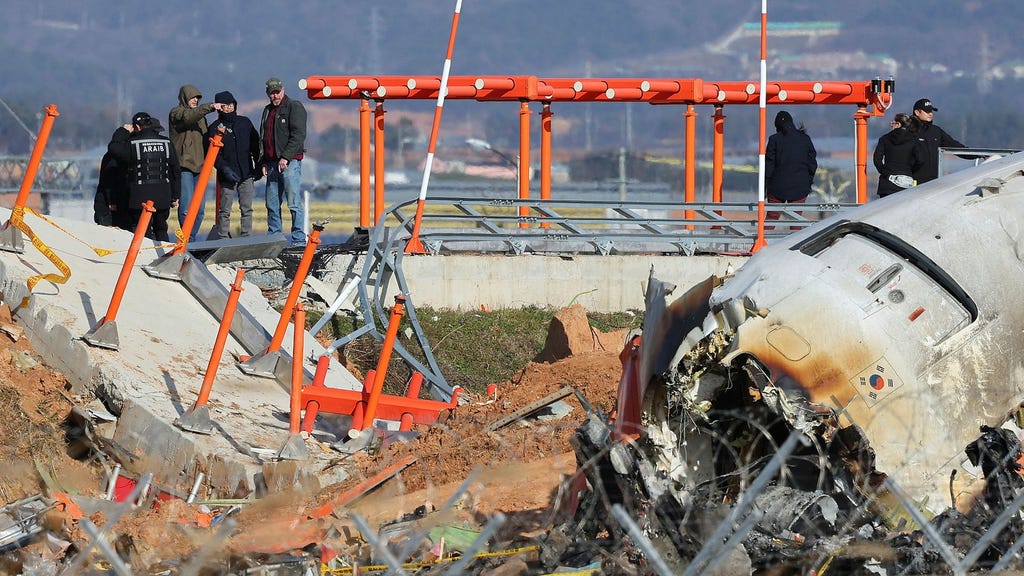The crash of Jeju Air flight from Bangkok on Sunday, December 29th, 2024, resulted in a devastating loss of life, claiming 179 victims, including four crew members, at Muan International Airport in South Korea. The aircraft, upon landing, inexplicably veered off the runway and collided with a concrete navigation instrument wall, subsequently engulfing the plane in flames. While two crew members miraculously survived, the incident marks the deadliest air disaster globally in 2024 and raises serious questions about the circumstances surrounding the tragedy.
The immediate cause of the crash remains undetermined, prompting extensive investigations encompassing various potential factors. Among these are the possibilities of a bird strike during landing and technical malfunctions within the aircraft’s steering system. Disturbing video footage captures the plane’s descent and impact without the deployment of its landing gear, adding another layer of complexity to the investigation. While routine checks before takeoff revealed no apparent issues with the aircraft, including the landing gear, according to Jeju Air CEO Kim Yi-Bae, the operational status of the landing gear at the time of the crash is a critical focus of the ongoing inquiry.
Jeju Air asserts that pre-flight maintenance and inspections were conducted meticulously, adhering to international aviation regulations. The airline’s current priority centers around providing unwavering support to the victims’ families and the survivors while concurrently implementing enhanced safety measures. As a preemptive measure, Jeju Air has announced plans to reduce its winter flight schedule by up to 15 percent to facilitate more comprehensive aircraft maintenance checks. This proactive approach aims to bolster safety protocols and address any potential concerns arising from the accident.
The positioning of the concrete navigation wall, which the aircraft ultimately struck, has drawn significant scrutiny from aviation safety experts. While South Korean authorities maintain that most airports in the country comply with international guidelines regarding the proximity of such structures to runways, the possibility of adjusting the wall’s location remains open under domestic regulations. The Infrastructure Ministry’s Kim Hong-Rak, Director General responsible for airport safety, emphasized the importance of reviewing existing regulations to identify and address potential contradictions, further highlighting the dedication to ensuring rigorous safety standards at all South Korean airports. Initial reports indicated that the wall stood approximately 250 meters from the runway’s end.
Adding further fuel to the debate surrounding the wall’s placement are documents from the airport operating company, obtained by Reuters, suggesting that the wall’s location was previously deemed problematic. The documents reportedly advocated for a greater distance between the runway and the wall during the airport’s expansion, raising concerns about whether adequate attention was given to these prior warnings. South Korean authorities have remained reticent on this specific issue, further emphasizing the need for a transparent and comprehensive investigation into the circumstances surrounding the crash. Independent aviation experts, citing industry standards, have suggested that such barriers should ideally be situated at least 300 meters from the runway’s end.
The tragic incident underscores the inherent risks associated with air travel and necessitates continuous vigilance in maintaining and enhancing safety protocols. While the investigation unfolds, the focus remains on determining the root cause of the crash and implementing necessary changes to prevent similar tragedies in the future. The loss of 179 lives serves as a somber reminder of the importance of prioritizing safety within the aviation industry, and the collective effort to understand and address the contributing factors to this accident will be crucial in improving air travel safety worldwide. The crash holds a significant position in the annals of aviation accidents, ranking as the deadliest air disaster of 2024 and recalling the tragic Tenerife airport disaster of 1977, where a collision between two aircraft resulted in 583 fatalities. The ongoing investigation, including the scrutiny of the concrete wall’s placement and potential technical malfunctions, will ultimately shape future safety guidelines and aim to prevent similar catastrophes.














